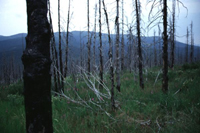Disturbance and the boreal forest
| Fire is a common disturbance in the boreal forest.
Each year, large areas of the boreal forest are consumed by wildfires.
Researchers have established that fire stimulates seed germination
and seedling survivorship; the boreal forest quickly replaces itself
following wildfire. |

|
The role of fires at treeline, however, remains relatively unstudied.
In the marginal and exposed conditions at the limits of the boreal forest
fires may have very different effects than the ones that have been documented
within the interior of the boreal forest. For example, the exposed conditions
that follow a fire may inhibit regeneration at treeline, where the shelter
(from wind and blowing ice, for example) may be critical for juvenile
survival. In addition, seed may be more scarce following a fire at treeline
than following a similar fire in the interior (where the burned patch
is surrounded on all sides by unburned forest).
It is likely that the frequency and severity of forest fires may change
as a result of future climate change at high latitudes. Warmer summer
temperatures, for example, may allow fuel to dry more, and promote more
frequent and/or more severe fires. The effects of such a change in fire
frequency for the boreal forest, particularly at treeline, are unknown.
|
